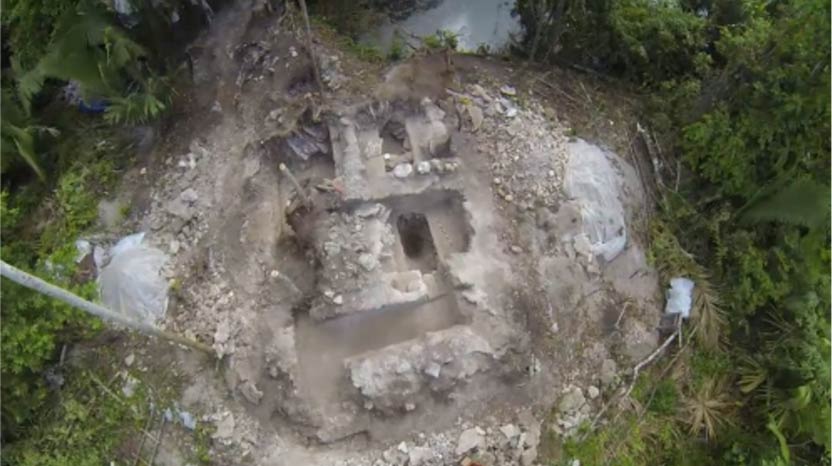Maya Water Temple Complex discovered where ritual offerings were made to placate the Rain God
Archaeologists have discovered that the Maya made offerings to Chaak, the rain god, at a newly discovered water temple complex alongside the sacred pools of Cara Blanca in Belize. The sacrifices appear to have been made to appeal for an end to the drought, as ritual activity increased around the time that lack of rainfall began unravelling the once great and powerful Maya civilization.
At the Cara Blanca site in Belize, openings in the earth, such as caves and pools, were considered to be portals to the underworld or Xibalba. The Maya left countless offerings around the 25 pools of Cara Blanca, to petition gods and ancestors to bring forth rain and bountiful crops.
According to National Geographic, the water temple complex consists of a small plaza with the collapsed remnants of a lodge and two smaller structures. The floors of the shrine were covered with potsherds and fossil teeth or claws. Small water jars, some decorated with water motifs of wavy lines and spirals, were also found.
"The pilgrims came there to purify themselves and to make offerings," University of Illinois archaeologist Lisa Lucero, who led the team that explored the ruins, told National Geographic. "It was a special place with a sacred function".

Divers trying to uncover mysteries of sacred Maya pools (topnews.in)
A new study that will be published in the upcoming Cambridge Archaeological Journal, Lucero and archaeologist Andrew Kinkella of Moorpark College in California, found that sacrificial offerings of pots, jars, and bowls, which were found in the depths of the Cara Blanca pools, increased around the time that drought had spread throughout the ancient Maya world.
Dating of the relics shows that there was only a small number of artifacts from the earlier periods, while numerous items were dated to the end stage of the civilization “when the Maya's need to placate Chaak, the rain god who lived in the depths, grew dire,” writes National Geographic.

Chaak, the Maya Rain God (Wikimedia Commons)
The Maya culture stretched across much of what is now southern Mexico, Belize, Honduras, El Salvador, and Guatemala, and thrived there for more than 2,000 years. Their advancement spanned the sciences, astronomy, mathematics, writing system, calendars and monumental constructions. Cities, like the magnificent Tikal, were ruled by a dominant elite who could command mighty armies. Yet over the course of only a century, beginning around the 8th century AD, the cities became abandoned and were left in ruins.
Recent research has shown that an extreme drought occurred between 800 and 900 AD, which corresponds to the time period in which the ancient Maya civilization collapsed.
The evidence for the drought explanation has been growing in recent years. In 2012, a study published in the Proceedings of the National Academy of Science, found that severe reductions in rainfall were coupled with an rapid rate of deforestation, as the Maya burned and chopped down more and more forest to clear land for agriculture. Another study the same year, published in the journal Science, analyzed a 2,000-year-old stalagmite from a cave in Belize and found that a sharp drop in rainfall coincided with the decline of the Maya civilization. More recently, a study, reported by Live Science, further strengthened the case that drought contributed to the downfall of the once powerful Maya.
"In the big picture, I do agree this [the water temple complex] was likely a shrine where ritual practices took place that point to times getting tough for people," archaeologist Holley Moyes of the University of California told National Geographic. "When you start getting down to actual drought, we are starting to see sacrifices picking up across the Maya world."
Featured image: Aerial footage of the newly discovered Maya water temple. Screenshot from National Geographic video.




















Comments
"Yet over the course of only a century, beginning around the 8th century AD..." ".....an extreme drought occurred between 800 and 900 AD......"
That is surely the ninth century AD, is it not?